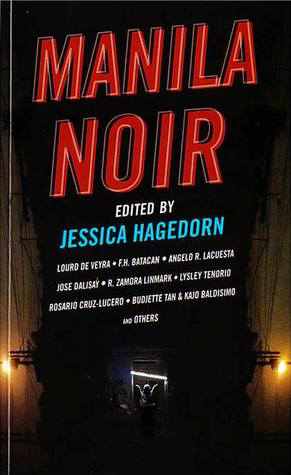Filtered by: Lifestyle
Lifestyle
Book review: Almost everyone is guilty in 'Manila Noir'
By MEANN ORTIZ

'Manila Noir' editor Jessica Hagedorn (standing, third from right) with some of the anthology's contributing authors at its launch. Photo courtesy of National Bookstore
News headlines seem like they come straight out of crime fiction stories, what with all the violence, corruption, betrayal, and morality of so many shades of grey, they can rival a certain bestselling book.
For proof that reality is starting to become just as strange as fiction, if not stranger, look no further than “Manila Noir”, a collection of short stories edited by acclaimed writer Jessica Hagedorn. The anthology is part of Akashic Books’ Noir Series set in various locales around the world.
'Manila—the ultimate femme fatale'
Hagedorn is a big fan of the Akashic Noir series, so much so that she approached publisher Johnny Temple herself to propose “Manila Noir” because Manila is “like a woman of mystery—the ultimate femme fatale. Sexy, complicated, tainted by a dark and painful past…a city of heat and shadows and secrets, perfect for this genre we call noir.”
After getting the green light from Temple, Hagedorn enlisted Lysley Tenorio, Rosario Cruz-Lucero, Lourd de Veyra, Sabina Murray, Angelo R. Lacuesta, Budjette Tan & Kajo Baldisimo, F.H. Batacan, Jose Dalisay, R. Zamora Linmark, Gina Apostol, Marianne Villanueva, Eric Gamalinda, and Jonas Vitman to contribute never-before-published stories set in different parts of Metro Manila.
The contributors rose to the occasion, penning stories set in not-quite-noir places like Greenbelt Mall and Forbes Park, to the seedy depths of Tondo, Ermita, and Chinatown, the secret tunnels of Intramuros, and even all along the MRT.
The Philippine edition of “Manila Noir” from Anvil Publishing was launched last July 7 at National Book Store in Glorietta, Makati City. Hagedorn was in attendance, along with Lucero, de Veyra, Lacuesta, Tan & Baldisimo, Batacan, Dalisay, and Linmark, who all read excerpts from their respective stories.
 Testing the boundaries
Testing the boundaries
For proof that reality is starting to become just as strange as fiction, if not stranger, look no further than “Manila Noir”, a collection of short stories edited by acclaimed writer Jessica Hagedorn. The anthology is part of Akashic Books’ Noir Series set in various locales around the world.
'Manila—the ultimate femme fatale'
Hagedorn is a big fan of the Akashic Noir series, so much so that she approached publisher Johnny Temple herself to propose “Manila Noir” because Manila is “like a woman of mystery—the ultimate femme fatale. Sexy, complicated, tainted by a dark and painful past…a city of heat and shadows and secrets, perfect for this genre we call noir.”
After getting the green light from Temple, Hagedorn enlisted Lysley Tenorio, Rosario Cruz-Lucero, Lourd de Veyra, Sabina Murray, Angelo R. Lacuesta, Budjette Tan & Kajo Baldisimo, F.H. Batacan, Jose Dalisay, R. Zamora Linmark, Gina Apostol, Marianne Villanueva, Eric Gamalinda, and Jonas Vitman to contribute never-before-published stories set in different parts of Metro Manila.
The contributors rose to the occasion, penning stories set in not-quite-noir places like Greenbelt Mall and Forbes Park, to the seedy depths of Tondo, Ermita, and Chinatown, the secret tunnels of Intramuros, and even all along the MRT.
The Philippine edition of “Manila Noir” from Anvil Publishing was launched last July 7 at National Book Store in Glorietta, Makati City. Hagedorn was in attendance, along with Lucero, de Veyra, Lacuesta, Tan & Baldisimo, Batacan, Dalisay, and Linmark, who all read excerpts from their respective stories.
 Testing the boundaries
Testing the boundariesLike most anthologies, “Manila Noir” is a mixed bag. There are excellent stories that are classic noir, while some test the boundaries of the genre. There are also stories that make such good use of their chosen location that it’s almost another character.
One of the standouts in the collection is Tan and Baldisimo’s “Thirteen Stations”, a graphic story set in the universe of their popular “Trese” series. This might just be the first graphic story ever included in an Akashic Noir book.
Tan admitted that, in a fit of desperation after learning that some of the Metro Manila locations he wanted were already spoken for, he told Hagedorn, “Okay, what about the entire MRT?”
He does use his chosen location to great effect. In fact, the next time I ride the MRT, I’m probably going to be looking around for some unusual occurrences that could be supernatural.
While “Thirteen Stations” was a great story and a great addition to the anthology, this is one of those that test the boundaries of noir. For most of the story, Alexandra Trese was out to catch the culprits. But although she solved the crime, she didn’t have enough solid evidence to pin on the criminals, so she couldn’t really bring them to justice.
As Hagedorn said, in noir, “everyone’s complicit to the crime. We’re all guilty.” But Trese isn’t, really, unless letting the suspects go because there was no evidence means being complicit to the crime. I suppose, at most, it can be classified as morally ambiguous.
There is a second “detective story” in the book: Batacan’s “Comforter of the Afflicted,” which saw the return of her iconic character from the award-winning “Smaller and Smaller Circles,” the Jesuit priest/criminologist Father Augusto Saenz.
This is yet another great story, one that is quite emotional and suspenseful. But it also pushes at the boundaries of noir because, like Trese, Saenz and the policeman Rueda can be considered heroic characters, and there are no heroic characters in noir.
However, the way Batacan wrote this made Saenz less of a protagonist but more like an observer, and Libby Delgado, the woman at the center of Saenz’s investigation, more the protagonist. Batacan described her as a “woman who is not quite what she seems”—a character that fits one of the tropes of noir. She is still quite the hero, though, just a very unfortunate one.
Thrilla in Manila
Many of the other stories fit firmly within noir territory, though. Hagedorn’s own “Old Money” set in Forbes Park is one that keeps on spiraling towards doom from the beginning and ends in a bloodbath. Dalisay’s “The Professor’s Wife,” meanwhile, features a classic and memorable femme fatale.
Linmark’s “Cariño Brutal” is short but it has quite an impact, and features some of the more ghastly imagery in the book. Vitman’s “Norma from Norman” takes the cake in terms of the level of gore, though, but it also has one of the more interesting characters in the anthology.
Gamalinda’s “Darling, You Can Count On Me” got creative with its narrative style by presenting various points of view. While it got a little confusing, the core story was still engaging.
De Veyra’s “Satan Has Already Bought You” is one of my favorite stories in the book, although it comes across to me as “noir light”. It has a lot of dark humor and the set-up is rather clever.
Parts of Lucero’s “A Human Right” provide good back story, but its strength is in the parts set in Intramuros itself, as the two protagonists take a tour of the walled city.
As for the other stories, I think they are still good in their own right. Some don’t fit in with my expectations of noir, while some were just a little less memorable, although they don’t affect the collection negatively.
As anthologies go, this is pretty strong and cohesive, and I recommend this to crime fiction enthusiasts and to those who are looking to read something provocative and thrilling set in this metropolis we live in. — BM, GMA News
Meann Ortiz is an engineer and freelance writer. She blogs at The Girl Who Read and Other Stories. The opinions expressed in this review are solely her own.
Find out your candidates' profile
Find the latest news
Find out individual candidate platforms
Choose your candidates and print out your selection.
Voter Demographics
More Videos
Most Popular





